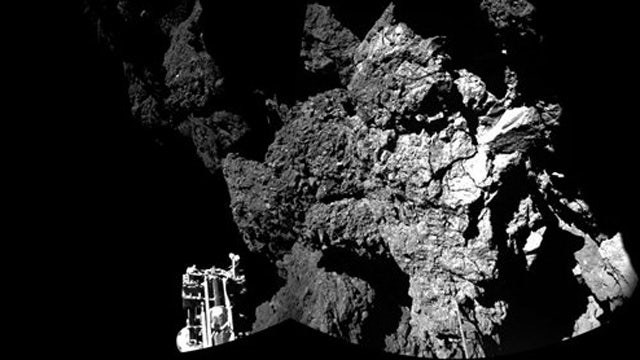Can the Philae lander still accomplish its mission?
Space.com's Dave Brody discusses the history-making mission and the problems that may have resulted from its landing
The European Space Agency’s Philae lander bounced twice before finally settling on comet 67P/Churyumov-Gerasimenko on Wednesday, leaving scientists uncertain about its exact location.
The good news is that Philae is stable and already collecting data to send back to Earth. However, the bad news is that the craft's useful lifetime may be significantly less than anticipated after it landed in the shadow of a cliff.
Philae's 60-hour battery will run out of power within a day or two. At that point, scientists had planned to use the lander's solar panels, which are designed to provide an hour of battery power each day. The shadow cast by the cliff now poses a huge challenge for the ESA.
"We see that we get less solar power than we planned for," said Koen Geurts of the ESA's lander team.
"This, of course, has an impact on our ... capabilities to conduct science for an extended period of time," he said. "Unfortunately this is not a situation that we were hoping for."
Philae made history when it became the first probe to land on a comet, ending its audacious 10-year journey to rendezvous with 67P/Churyumov-Gerasimenko.
ESA scientists, however, soon reported that the washing machine-sized craft may have landed twice. The comet, which is about 2.5 miles wide, travels at speeds up to 84,000 miles per hour.
Speaking on a press conference early on Thursday, Lander Project Manager Stephan Ulamec confirmed that, after touching down in the correct location, the probe’s first bounce lasted 2 hours and took the craft up to a distance of more than half a mile.
The second bounce was “a very small jump” of just over an inch per second for 7 minutes. “It makes it hard for us to know where we are now,” he added.
Scientists, however, have identified an area of the comet where it may be.
“We will have a chance to find the lander,” said Holger Sierks, principal investigator of the Osiris imaging system on the Rosetta spacecraft that carried Philae. Sierks noted that ESA is already investigating two possible locations.
During its press conference, ESA officials showed images from the landing site, revealing that Philae eventually landed on rock-like material, apparently on the rim of a crater.
“Astonishing – we thought that we would land on powder material,” said Jean-Pierre Bibring, the Philae lead scientist. “We will have more information in the coming hours.”
The images also show that Philae landed very near a cliff face. “It’s probably a matter of meters,” said Bibring. “We’re very close by.”
According to the images, one of the lander’s three ‘feet’ is not resting on the comet’s surface, and may be above a hole or depression.
In response to a journalist’s question, Ulamec said that, with only two feet on the comet’s surface, Philae is unlikely to make a planned “jump” to another location.
“We could, in principle, operate the landing gear,” he said, explaining that this could shift the lander. “It would be very, very, difficult.”
The ESA also released the first panoramic picture taken from the Philae lander. The three feet of Philae's landing gear can be seen in some of the frames.
Earlier on Thursday, the ESA released the first picture taken by the probe after determining that the craft had stabilized following a tension-filled landing. Harpoons meant to anchor the lander to the surface failed to work properly, causing Philae to bounce twice.
Gerhard Schwehm, a scientist on the Rosetta mission, told The Associated Press that it may still be possible to fire the harpoons but in any case the lander is "very healthy." However, Ulamec told the BBC that he was wary of making another attempt to fire the harpoons on the grounds that Philae could be thrown back into space.
Although the mission clearly faces ongoing challenges, experts have lauded the ESA’s achievement in reaching the comet. Daniel Brown, an astronomy expert at Nottingham Trent University in the U.K., is particularly impressed with the collaborative nature of the comet mission.
The lander was developed by a European consortium led by the German Aerospace Research Institute (DLR), which includes ESA and institutes from a number of countries, including the U.K.
“I would attribute the success of the landing to the successful collaboration of a big international team that were responsible for developing Rosetta and Philae,” Brown said, in an email to FoxNews.com. “This also includes nations beyond the E.U., for example, the U.S. and Australia, that not only supported with instruments on board but also with the provision of tracking stations etc.”
“It has shown us what we can achieve when we work together,” Brown added. “For such a landing everything had to be spot on and this was also a huge achievement from the team dealing with the trajectory of Rosetta.“
A key question remains whether Philae's drill can be used to extract samples from beneath the surface without pushing the lander into space. Gravity on the comet is 1/100,000th that of Earth, meaning the lander weighs just 0.04 ounces there.
Philae and Rosetta will use 21 instruments to analyze the comet. Scientists hope the $1.62 billion will help them better understand comets and other celestial objects, as well as possibly answer questions about the origins of life on Earth.
Follow James Rogers on Twitter @jamesjrogers
The Associated Press contributed to this report.





















